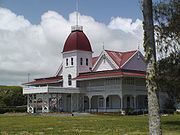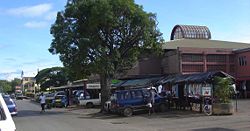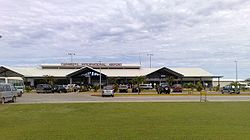
. It is located on the north coast of the island of Tongatapu
, in the southern most island group of Tonga.
Mythological origins
In the Tongan myth of the origin of Nukualofa, it was said that the meaning of Nukualofa is: nuku meaning abode, alofa meaning love.The name is said to have originated when Moungatonga, the 6th Tui Haatakalaua (King who governs the daily business of Tonga on behalf of the Tui Tonga or Sacred King of Tonga) sent his youngest son, Ngata (later to be 1st Tui Kanokupolu) as governor to Hihifo (Western side of Tongatapu). It was a difficult decision for Ngata as the Tu’i Tonga and Tu’i Ha’atakalaua have been unable to control Hihifo. Ngata had many reasons to fear for his life as his predecessors had been killed by the chiefs and people of Hihifo.
When Ngata left Mua, the old capital and residence of the Tui Tonga and Tui Ha'atakalaua, he was escorted by Nuku (an uncle) and Niukapu (an older cousin), chiefly relatives of his father. They sailed their canoes with all their followers from Mua and debated abandoning Tonga and sailing directly to Samoa, the homeland of Ngata’s mother. It was decided not to abandon Tonga, but to pull their canoes up into the swamp area halfway between Mua and Hihifo in order to plan and prepare for their landing at Hihifo.
Ngata, Nuku and Niukapu decided to wrap their combined bodies under a large mat and land in Hihifo, giving the impression of a large man with three heads. This is the origin of the Ulutolu (Three Head Story) and of the Haa Tui Kanokupolu, third lineage King of Tonga. They named the swampy area as Nuku (Abode) Alofa (Love) or the Abode of Love, thus Nukualofa.
First western records of Nukualofa
On 10 June 1777, British captain James Cookwrote of his arrival at their anchorage place. His description of the place confirmed, with his map, that this was the bay of Nukualofa.
At length, about two in the afternoon, we arrived at our intended station. It was a very snug place, formed by the shore of Tongataboo on the South East, and two small islands on the East and North East. Here we anchored in ten fathoms water, over a bottom of oozy sand; distant from the shore one-third of a mile."
Cook never used the name Nukualofa or any other spelling for the reports of this voyage, but he mentioned the island of Pangaimodoo (Pangaimotu) which was to the east of his anchorage position. Captain Cook also wrote that he travelled by canoes to visit Mooa (Mua) where Paulaho and other great men lived. The house that Paulaho provided was on the beach a third of a mile from the ship. Reference to his map shows that he must have landed and stayed in the Siesia area, the eastern part of modern Nukualofa. Cook also drafted the first map of the bay of Nuku'alofa.
The first written record for Nuku'alofa is stated in the first dedicated book for Tonga by George Vason which was published in 1810. George Vason was an English missionary from the London Missionary Society
, who arrived in Tonga in 1797. George Vason wrote of their arrival that:
Before we could well come to an anchor, the ship was surrounded by the natives, who flocked to us from every adjacent Island. The place, before which we anchored, was called Noogollefa: it was near an Island, named Bonghy-moddoo; on which former navigators pitched their tents, as a convenient spot, on account of its separation from the main Island, to preserve themselves from being two much incommoded by the natives.
That was the first mention of Nuku'alofa, spelled as Noogoollefa. Pangaimotu was spelled as Bongy-Moddoo by George Vason since Tongan writing and alphabet would be developed in 1826-27.
The second oldest book dedicated to Tonga was by William Mariner, adopted son of Finau 'Ulukalala, which was published in 1817. Mariner described his experiences during the years he was the adopted son of 'Ulukalala (1806–1810). He described the civil war and the siege of the Fort of Nuku'alofa, which fell to 'Ulukalala and his warriors
The third attempt of Christian missionaries were recorded in April 1826, when two Tahitian London Missionaries were detained by Tupou the chief of Nuku'alofa.
In March 1826, the four men left Tahiti in the Minerva, their destination Fiji. But at Nuku’alofa, Tonga, their plans were disrupted by the high chief Tupou (Aleamotu’a). From Davies’ perspective the Tahitian were placed under detention at Tongatapu: “The chief called Tupou would not let them proceed. He had been himself a resident in Lageba and calls himself the friend of Tuineau, the chief of Lageba and as such he took possession of the present intended for the Fijian chief.
The arrival of the Methodist missionaries in Nuku'alofa in 1827 reinforced the Christian faith. The persecution suffered by Christians in Hihifo and Hahake forced a lot of people to seek refugees in Nuku'alofa. Thanks to the encouragement of Tupou, the King of Nuku'alofa, this was the beginning of the expanding of Nuku'alofa to become the major center of Christianity in Tonga.
The final phase of the arrival of Christianity in Tonga was the arrival of Father Chevron, or Patele Sevelo, in 1842. He wrote that he arrived in Nuku'alofa in 1842 and met the Tu'i Kanokupolu Aleamotu'a who was baptised by the Wesleyan as Sosaia."
In conclusion, these arrival turned Nuku'alofa from a small village and fort into the center of Tonga during the arrival of Christianity.
From the earliest record for Nuku'alofa, the early writer always refer to the settlement as Noogollefa (1797), Nioocalofa (1806), Nukualofa (1826 by Methodist) and Noukou-Alofa (1842 by French Catholic Priest). There was no other mention of any other name of the settlement but only of the settlement or fort of Nuku'alofa.
Capital of the Kingdom of Tonga (1875)
The Declaration of the Constitution of Tonga in 1875 formalised Nuku'alofa as the Capital of Tonga. King George Taufa'ahau Tupou I issued the Constitution of Tonga on 4 November 1875, in Nuku'alofa. The Constitution also stated (Article 38) that the Parliament will meet in Nuku'alofa except in time of war.Since Nuku'alofa have been expanding from when it became the center of Christianity in Tonga in the 19th century, it became essential that it was reorganised for effective administration of the capital. The reorganisation of Nuku'alofa divided up Nuku'alofa into three major district area:

- Kolomotu'a (Kolo meaning "town" or "settlement", motu'a meaning "old"), encompassing the city's original settlement of Nuku'alofa, including all the area of the old Fort of Nuku'alofa and all the western area where it was the traditional settlement of the Tu'i Kanokupolu from Mumui the 13th Tu'i Kanokupolu to Aleamotu'a the 18th Tu'i Kanokupolu.
- Kolofo'ou (fo'ou meaning "new"). This area started from the old Fort of Nuku'alofa to all the eastern side, including the home of King George Taufa'ahau Tupou I, as well as all the new settlement and seat of government of Tonga.
- Ma'ufangaNuku'alofaNukualofa is the capital of the Kingdom of Tonga. It is located on the north coast of the island of Tongatapu, in the southern most island group of Tonga.-Mythological origins:...
, on the eastern side of Nuku'alofa. Ma'ufanga was an old village of the Ha'a Takalaua, which is the Estate of the Chief Fakafanua. George Vason mentioned that Ma'ufanga was a refugees area during the civil war, where people could take shelter in time of hardship. Ma'ufanga is the area facing Pangaimotu, where James Cook anchored, and where Paulaho built him a house on the beach, about 500 meters from the ship.
While Nuku'alofa have smaller suburbs with different names and with different claimed histories, the three district of Nuku'alofa is mention above where they are administered to the current days.
Government
There are district officers (ofisa vahe) and town officers (ofisa kolo), as in all villages of Tonga. Their main task is to disseminate the orders of the government to the people. Vacancies for town officer positions are usually advertised in the local newspapers. Services such as police, fire brigade, and hospitals are arranged by the national government.The national government is based in Nukualofa. The parliament of Tonga meets there, and the Royal Palace is located near the city. The city is home to the embassies of foreign countries.
Economy

Peau Vava'u
, an airline, had its head office in the Pacific Royale Hotel in Nukuʻalofa. The former Royal Tongan Airlines
had its head office in the Royco Building in Nukualofa.
The city has markets and a central business district. Much of the central business district was destroyed during the 2006 Nuku'alofa riots
, but it is being rebuilt.
Transport
Nukualofa is the central hub for transport in Tonga.Buses arrive and depart from the central bus station along Vuna Road close to the centre of town. Bus services are privately operated, and their drivers are free to set their own schedules. Fares are fixed by the government, with reduced rates for school children. The buses are usually filled to capacity. In addition, some schools and large hotels provide their own buses.
There are numerous taxis, also privately owned. Many people who own a car earn extra money by providing taxi services in their spare time. Taxi fares are also set by the government. Most families have their own car; few residents ride bicycles. There are no operational railways or trams in Tonga, although there was once a narrow-gauge railway from the lagoon to the wharf, which gave its name to Railway Road.

each day, and two to Haapai
and Vavau
each week. In addition to these regular services by shipping companies, private boat owners provide less regular services to smaller islands such as Nomuka
and Eueiki.
Air transport is provided by Fuaamotu International Airport on the south side of Tongatapu, 35 kilometres from Nukualofa.

